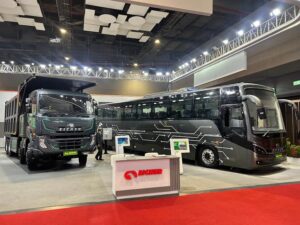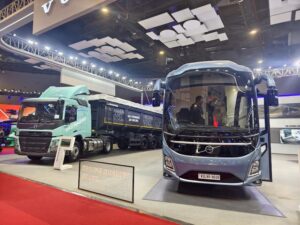VECV has adopted a strategic approach to the electric bus market, achieving a significant milestone by entering the sleeper bus segment with EV models. ‘We have ensured full compliance with all government safety and performance regulations,’ said Suresh Chettiar, Executive Vice President of the Bus Division at VE Commercial Vehicles Ltd (VECV) for Volvo Buses India operations.
Q: Volvo buses have long been known for their strong market presence and premium positioning. Could you elaborate on what defines a Volvo bus, particularly in the context of the 9600 Series?
Volvo has always been at the forefront of innovation and premium mobility solutions in the bus and coach segment. Our focus has been to deliver superior quality, safety, and performance while ensuring a luxurious travel experience. When we talk about the Volvo 9600 Series, we are essentially referring to a highly refined and modern adaptation of our globally recognized coach design, optimized for the Indian market.
To put this in perspective, Volvo’s 9000 series represents our flagship premium range of long-distance coaches worldwide. Within this segment, we have models such as the Volvo 9600 and 9900, each tailored for different markets and varying levels of luxury. In Europe, we also have the Volvo 9700 DD, which is a double-decker version catering to high-capacity travel requirements. Each of these models, while unique, embodies our core design philosophy of comfort, efficiency, and safety.
Q: You mentioned that the 9600 Series is adapted for India. Could you shed some light on what specific modifications have been made for the Indian market?
The Volvo 9600 Series has been specifically adapted for the Indian market while maintaining the brand’s globally renowned engineering principles. India’s diverse and dynamic road conditions, ranging from highways to hilly terrains, necessitated several key modifications to ensure durability, efficiency, and passenger comfort.
The body structure and chassis have been reinforced to withstand Indian road conditions while retaining Volvo’s core European technology. These structural enhancements provide added durability, ensuring the bus can handle varying terrains with ease. Understanding the unique demands of Indian operators, the 9600 Series has been customized to offer multiple configurations, including sleeper and seater options, to balance comfort and practicality.
Ride quality has been a major focus, given the variability in Indian road conditions. The bus is equipped with an advanced suspension system that ensures a smooth and stable ride, even on uneven surfaces. Fuel efficiency is another critical aspect, considering the cost sensitivity of the Indian market. The 9600 Series integrates fuel-efficient engine technology without compromising on power output, making it ideal for long-haul travel.

Passenger comfort remains at the core of Volvo’s offerings, and the 9600 Series is no exception. With ergonomic seating, enhanced noise and vibration control, and an advanced air-conditioning system, it delivers a superior travel experience. These adaptations make the Volvo 9600 Series a perfect blend of durability, efficiency, and luxury, tailored to meet the unique needs of Indian travelers and operators.
Q: Volvo has a strong history in the Indian market with the 9400 Series being a popular choice for many years. What led to the introduction of the 9600 Series?
The Volvo 9400 Series was indeed a game-changer for the Indian coach segment, setting new benchmarks in terms of safety, comfort, and technology. However, as technology advances and customer expectations evolve, we continually innovate to stay ahead. The launch of the Volvo 9600 Series was a natural progression to introduce the latest in bus technology, adapted specifically for India.
The 9600 Series brings a host of improvements over the 9400, including enhanced aerodynamics, improved fuel efficiency, and better passenger amenities. Additionally, with the growing demand for sleeper coaches in India, the 9600 Series includes a factory-built sleeper coach configuration, which has been a significant step forward in the Indian premium coach segment.
Q: Do you have any plans to launch the Volvo 9900 series buses in the Indian market? If so, when can we expect it?
This period is crucial for the global automotive industry, particularly in Europe, where numerous new models and updates are introduced. However, the bus market in India follows a distinct timeline.
Several factors influence the launch of new products, with our primary focus on understanding customer needs and assessing market readiness. The bus industry is undergoing a significant transformation, driven by the growing emphasis on electric and sustainable mobility solutions. While Volvo remains committed to innovation and the development of advanced products, the timing of new launches depends on multiple considerations, including regulatory policies, infrastructure readiness, and evolving customer expectations.
Unlike passenger cars, which undergo annual updates, buses have a longer product lifecycle. This requires a strategic approach, ensuring each new model is thoroughly tested and optimized for long-term performance. The Volvo 9600 series, for instance, was the result of extensive research and development, designed specifically to meet the demands of Indian conditions.
Q: What can we expect from Volvo in the near future in terms of product innovations and market strategy?
Volvo remains deeply committed to transforming public transport with innovative, sustainable, and high-quality mobility solutions. In the near future, we are looking at expanding our portfolio with cleaner and greener alternatives. Electrification is a major area of focus, and we are continuously exploring opportunities to introduce electric and hybrid buses that align with India’s growing push towards sustainable transportation.
Additionally, digitalization and connectivity will play a crucial role in the future of mobility. We are working on smart solutions that enhance fleet management, passenger safety, and overall efficiency. As a brand, our goal remains clear—to continue setting benchmarks in luxury and performance while addressing the changing needs of the market.
Q: What is the production capacity of the Volvo 9600 at your Pithampur and Hoskote plants?
Our production capacity is always dictated by market demand. The Pithampur plant is designed to manufacture approximately 2,000 buses annually. Given the strong demand and overwhelmingly positive response to the new 9600 model, we are scaling up production to meet market needs.
The feedback from customers and passengers has been exceptional. We have noticed that passengers now specifically request to travel in the 9600 model, which is a clear indicator of its success and growing popularity in the market. We have implemented a range of flexible strategies that enable us to scale our production capacity efficiently in response to increasing market demand for buses.

Q: How do you see the overall bus market industry evolving by 2025?
The bus market is currently in an unprecedented growth phase, fueled by multiple factors. India’s economy is on a strong upward trajectory, supported by an expanding urban middle class, increasing disposable incomes, and robust infrastructure development. All of these factors contribute significantly to the increasing demand for public transportation.
For our segment, particularly intercity transport, the expansion of national highways and expressways has dramatically improved connectivity. As a result, Volvo buses are now reaching almost every city in India.
In terms of industry growth, we anticipate the overall bus sector to expand by approximately 15-20% in the current year compared to last year. However, the intercity and premium bus segments are witnessing even higher growth rates, potentially reaching 30-50%. Similarly, the demand for both Volvo and Eicher brand buses continues to experience steady growth.
Q: What is the current market penetration of electric buses, particularly Eicher Buses?
We have taken a strategic approach toward the electric bus market, which is currently dominated by government tenders. Instead of participating in every tender, we have chosen to focus on niche segments where we can provide maximum value.
We began our electric vehicle (EV) journey with nine-meter buses, catering to both public transport and private operators. Our EV buses are already in operation in cities such as Chandigarh, Trivandrum, and Kochi. Additionally, we have deployed EV buses for metro feeder services and staff transportation applications.
One of our unique achievements has been our entry into the sleeper bus segment with EV models. We have ensured compliance with all government safety and performance regulations. Furthermore, we have integrated advanced connectivity features across our Eicher range of buses to enhance safety and passenger experience. Safety remains a core value for both Volvo and Eicher, which aligns with our brand’s legacy.
Q: What are the key challenges in research and development for both Volvo and Eicher?
Our primary focus in research and development (R&D) is to ensure that we meet and exceed market expectations with every new product. Whether it’s diesel or electric buses, we remain committed to innovation and continuous improvement.
For EVs, we initially introduced nine-meter buses and are now working on larger variants. This is a clear indication of our commitment to being a key player in the electric mobility transition.
In the diesel segment, we have already covered the entire market with our offerings. Our major priority is modernization—enhancing efficiency, comfort, and safety. I do not view R&D as a challenge but rather as an ongoing process of staying ahead of industry trends and evolving customer needs.